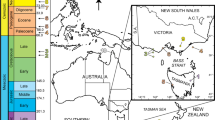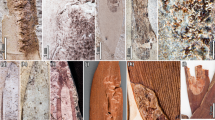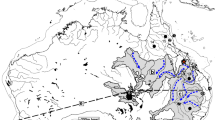Abstract
The origin of trees by the mid-Devonian epoch (398–385 million years ago) signals a major change in terrestrial ecosystems with potential long-term consequences including increased weathering, drop in atmospheric CO2, modified climate, changes in sedimentation patterns and mass extinction1,2,3. However, little is known about the ecology of early forests or how changes in early terrestrial ecosystems influenced global processes. One of the most famous palaeontological records for this time is the ‘oldest fossil forest’ at Riverside Quarry, Gilboa, New York, USA, discovered in the 1920s4,5. Hundreds of large Eospermatopteris sandstone casts, now thought to represent the bases of standing cladoxylopsid trees6, were recovered from a horizon that was originally interpreted as a muddy swamp. After quarry operations ceased, relatively minor outcrops of similar fossils at nearby localities have provided limited opportunities to evaluate this pervasive view using modern methods7,8. In 2010, removal of the quarry backfill enabled reappraisal of the palaeoecology of this important site. Here we describe a 1,200 m2 map showing numerous Eospermatopteris root systems in life position within a mixed-age stand of trees. Unexpectedly, large woody rhizomes with adventitious roots and aerial branch systems identified as aneurophytalean progymnosperms run between, and probably climb into, Eospermatopteris trees. We describe the overall habit for these surprisingly large aneurophytaleans, the earliest fossil group having wood produced by a bifacial vascular cambium. The site also provides evidence for arborescence within lycopsids, extending the North American range for trees in this ecologically critical group. The rooting horizon is a dark grey sandy mudstone showing limited root penetration. Although clearly belonging to a wetland coastal plain environment9, the forest was probably limited in duration and subject to periodic disturbance. These observations provide fundamental clarification of the palaeoecology of this mixed-group early forest, with important implications for interpreting coeval assemblage data worldwide.
This is a preview of subscription content, access via your institution
Access options
Subscribe to this journal
Receive 51 print issues and online access
$199.00 per year
only $3.90 per issue
Buy this article
- Purchase on Springer Link
- Instant access to full article PDF
Prices may be subject to local taxes which are calculated during checkout




Similar content being viewed by others
References
Algeo, T. J., Scheckler, S. E. & Maynard, J. B. in Plants Invade the Land: Evolutionary and Environmental Approaches (eds Gensel, P. G. & Edwards, D. ) 213–236 (Columbia Univ. Press, 2001)
Davies, N. S. & Gibling, M. R. Paleozoic vegetation and the Siluro–Devonian rise of fluvial lateral accretion sets. Geology 38, 51–54 (2010)
Driese, S. G. & Mora, C. I. in Plants Invade the Land: Evolutionary and Environmental Approaches (eds Gensel, P. G. & Edwards, D. ) 237–253 (Columbia Univ. Press, 2001)
Goldring, W. The Upper Devonian forest of seed ferns in eastern New York. NY State Mus. Bull. 251, 50–72 (1924)
Goldring, W. The oldest known petrified forest. Sci. Mon. 24, 514–529 (1927)
Stein, W. E., Mannolini, F., Hernick, L. V., Landing, E. & Berry, C. M. Giant cladoxylopsid trees resolve the enigma of the Earth’s earliest forest stumps at Gilboa. Nature 446, 904–907 (2007)
Driese, S., Mora, C. I. & Elick, J. M. Morphology and taphonomy of root and stump casts of the earliest trees (Middle to Late Devonian), Pennsylvania and New York, U.S.A. Palaios 12, 524–537 (1997)
Mintz, J. S., Driese, S. G. & White, J. D. Environmental and ecological variability of Middle Devonian (Givetian) forests in Appalachian Basin paleosols, New York, United States. Palaios 25, 85–96 (2010)
Greb, S. F., DiMichele, W. A. & Gastaldo, R. A. Evolution and importance of wetlands in earth history. Geol. Soc. Am. Spec. Pap. 399, 1–40 (2006)
Berry, C. M. & Fairon-Demaret, M. The architecture of Pseudosporochnus nodosus Leclercq et Banks: a Middle Devonian Cladoxylopsid from Belgium. Int. J. Plant Sci. 163, 699–713 (2002)
Beck, C. B. Current status of the Progymnospermopsida. Rev. Palaeobot. Palynol. 21, 5–23 (1976)
Meyer-Berthaud, B., Scheckler, S. E. & Wendt, J. Archaeopteris is the earliest known modern tree. Nature 398, 700–701 (1999)
Retallack, G. J. & Huang, C. Ecology and evolution of Devonian trees in New York, USA. Palaeogeogr. Palaeoclimatol. Palaeoecol. 299, 110–128 (2011)
Banks, H. P., Grierson, J. D. & Bonamo, P. M. The flora of the Catskill clastic wedge. Geol. Soc. Am. Spec. Pap. 201, 125–141 (1985)
Beck, C. B. & Wight, D. C. in Origin and Evolution of Gymnosperms (ed. Beck, C.B. ) 1–84. Columbia Univ. Press, New York, 1988)
Dannenhoffer, J. M., Stein, W. & Bonamo, P. M. The primary body of Rellimia thomsonii: integrated perspective based on organically connected specimens. Int. J. Plant Sci. 168, 491–506 (2007)
Hammond, S. E. & Berry, C. M. A new species of Tetraxylopteris (Aneurophytales) from the Devonian of Venezuela. Bot. J. Linn. Soc. 148, 275–303 (2005)
Pigg, K. B. Evolution of Isoetalean lycopsids. Ann. Mo. Bot. Gard. 79, 589–612 (1992)
Gensel, P. G. & Berry, C. M. Early lycophyte evolution. Am. Fern J. 91, 74–98 (2001)
Grierson, J. D. & Banks, H. P. Lycopods of the Devonian of New York State. Palaeontogr. Am. 4, 217–295 (1963)
Berry, C. M. & Edwards, D. A new species of the lycopsid Gilboaphyton Arnold from the Devonian of Venezuela and New York State with a revision of the closely related genus Archaeosigillaria Kidston. Rev. Palaeobot. Palynol. 96, 47–70 (1997)
White, D. A remarkable fossil tree trunk from the middle Devonic of New York. NY State Mus. Bull. 107, 328–340 (1907)
Miller, M. F. & Woodrow, D. L. in Dynamic Stratigraphy and Depositional Environments of the Hamilton Group (Middle Devonian) in New York State, Part II (eds Landing, E. & Brett, C.E. ) 153–177 (State Education Department, 1991)
Bridge, J. S. The geometry, flow patterns and sedimentary processes of Devonian rivers and coasts, New York and Pennsylvania, USA. Geol. Soc. Lond. Spec. Publ. 180, 85–108 (2000)
Berry, C. M. & Fairon-Demaret, M. in Plants Invade the Land: Evolutionary and Environmental Approaches (eds Gensel, P. G. & Edwards, D.) 120–139 (Columbia University Press, 2001)
Bridge, J. S. & Willis, B. J. Marine transgressions and regressions recorded in Middle Devonian shore-zone deposits of the Catskill clastic wedge. Geol. Soc. Am. Bull. 106, 1440–1458 (1994)
Baird, G. C. & Brett, C. E. Late Givetian (Taghanic) bioevents in New York State: new discoveries and questions. Bull. Geosci. 83, 357–375 (2008)
Wright, V. P., Taylor, K. G. & Beck, V. H. The paleohydrology of lower Cretaceous seasonal wetlands, Isle of Wight, southern England. J. Sediment. Res. 70, 619–632 (2000)
Acknowledgements
Financial support was provided by the New York State Museum. C.M.B. acknowledges support from the UK Natural Environment Research Council (NERC) grant NE/F010699/1. Permission to work at the site by New York City Department of Environmental Protection (DEP) is acknowledged. On-site and other assistance was provided by E. Chase, P. Costa and G. Heath (DEP), as well as by P. Kollak and C. Tompkins of the Thalle Construction Company. We also thank P. Wright for advice and guidance on the major palaeosol horizon.
Author information
Authors and Affiliations
Contributions
L.V.H. and F. M. were responsible for collections and analysis, W.E.S. for mapping, C.M.B. for geological section, and W.E.S. and C.M.B. for palaeoecological interpretation. W.E.S. led the writing of the paper with substantial contributions from C.M.B.
Corresponding author
Ethics declarations
Competing interests
The authors declare no competing financial interests.
Supplementary information
Supplementary Information
This file contains a Supplementary Discussion comprising: Survey data and site comparison; Geology, palaeoenvironmental setting and age; Use of names for the fossil remains; Criteria for recognizing Eospermatopteris root systems; Difficulties in estimating height for Eospermatopteris trees; Identity of aneurophytaleans at Gilboa; Aneurophytalean rhizome compression collected by Goldring; The arborescent lycopsid at Gilboa and Supplementary References. Supplementary Figures 1-27 with legends are also included. (PDF 10436 kb)
Rights and permissions
About this article
Cite this article
Stein, W., Berry, C., Hernick, L. et al. Surprisingly complex community discovered in the mid-Devonian fossil forest at Gilboa. Nature 483, 78–81 (2012). https://doi.org/10.1038/nature10819
Received:
Accepted:
Published:
Issue Date:
DOI: https://doi.org/10.1038/nature10819
This article is cited by
-
Mapping amorphous SiO2 in Devonian shales and the possible link to marine productivity during incipient forest diversification
Scientific Reports (2023)
-
Re-study of Guangdedendron micrum from the Late Devonian Xinhang forest
BMC Ecology and Evolution (2022)
-
A Late Devonian tree lycopsid with large strobili and isotomous roots
Communications Biology (2022)
-
The impact of vegetation on meandering rivers
Nature Reviews Earth & Environment (2022)
-
Formalizing planning and information search in naturalistic decision-making
Nature Neuroscience (2021)
Comments
By submitting a comment you agree to abide by our Terms and Community Guidelines. If you find something abusive or that does not comply with our terms or guidelines please flag it as inappropriate.



